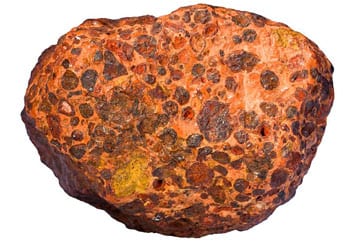Izvēlieties valodu:
Aluminum is the most common metal element found on Earth, totaling about 8% no Zemes garozas. Tomēr, aluminum as an element is reactive and therefore does not occur naturally – it needs to be refined to produce aluminum metal. Primārais izejmateriāls alumīnija rafinēšanai ir boksīts, pasaulē galvenais komerciālais alumīnija avots. Bauxite is a sedimentary rock, and consists mostly of the aluminium minerals gibbsite (Al(AK)3), boehmite (γ-AlO(AK)) un diaspore (α-AlO(AK)), and is usually mixed with the two iron oxides goethite and hematite, the aluminium clay mineral kaolinite and small amounts of anatase (TiO2) and/or ilmenite (FeTio3).

Boksīta noguldījumi tiek izplatīti visā pasaulē, galvenokārt sastopama tropu vai subtropu reģionos. Although proven reserves of bauxite are expected to last for many years, to rezervju kvalitāte, kurām var piekļūt ekonomiski, samazinās. Rafinētājiem, who are in the business of bauxite processing to make alumina, un galu galā alumīnija metāls, tā ir problēma, kas ietekmē gan finansiālo, gan vides.
The process to refine metallurgical bauxite into alumina involves the following inputs:
The following outputs are generated:

The most widely used chemical process of refining bauxite into alumina, the Bayer process, involves dissolving the Al2O3 out of the bauxite rock with caustic soda (Naoh) at elevated temperature and pressure. The Al2O3 fraction of the bauxite is dissolved into solution, to later be precipitated out as alumina. Tomēr, a high-grade bauxite contains up to 60% Al2O3 Al2O3, and many operating bauxite deposits are well below this, reizēm tik zemu kā 30-40% Al2O3 Al2O3. Because the desired product is a high purity Al2O3, atlikušos oksīdus boksītā (Fe2O3 (Fe2O3), SiO2 SiO2, TiO2, Organic material) are separated from the Al2O3 and rejected as alumina refinery resides (ARR) or red mud. Kopumā, jo zemāka kvalitāte ir boksīta (ie lower Al2O3 content) the more red mud is generated per ton of alumina product. turklāt, even some Al2O3 bearing minerals, īpaši kaolinīts, produce un-desirable side reactions during the refining process and lead to an increase in red mud generation, kā arī dārgu kaustiskā sodas ķīmiskās vielas zudumu, lielas mainīgās izmaksas boksīta rafinēšanas procesā.
Sarkanie dubļi vai ARR ir liels un notiekošs izaicinājums alumīnija rūpniecībai. Sarkanie dubļi satur ievērojamus atlikušos kodīgās ķīmiskās vielas pārpalikumus rafinēšanas procesā, un ir ļoti sārmains, bieži ar pH 10 - 13. It is generated in large volumes worldwide – according to the USGS, aplēstā alumīnija oksīda ražošana pasaulē bija 121 miljoni tonnu 2016. This likely resulted in more than 150 miljons tonnu sarkano dubļu, kas radušies tajā pašā periodā. Neraugoties uz notiekošajiem pētījumiem,, sarkanajiem dubļiem pašlaik ir maz komerciāli dzīvotspējīgu ceļu uz lietderīgu atkārtotu izmantošanu. Tiek lēsts, ka ļoti maz sarkano dubļu tiek lietderīgi atkārtoti izmantoti visā pasaulē. Instead the red mud is pumped from the alumina refinery into storage impoundments or landfills, kur to uzglabā un uzrauga par lielām izmaksām.
Dārgas kaustiskās sodas zudums (Naoh) and the generation of red mud are both related to the quality of the bauxite used in the refining process. Kopumā, the lower the Al2O3 content of the bauxite, jo lielāks būs sarkano dubļu apjoms, kas tiks ģenerēts, as the non-Al2O3 phases are rejected as red mud. turklāt, the higher the kaolinite or reactive silica content of the bauxite, jo vairāk sarkano dubļu tiks ģenerēti. The reactive silica content not only increases the volume of red mud, but also consumes caustic soda reagent and reduces the yield of Al2O3 recovered from the bauxite. Tādēļ, there is both an economic and environmental argument to be made for improving the quality of bauxite prior to refining.
STET sausās atdalīšanas process piedāvā boksīta ražotājiem vai boksīta pārstrādes uzņēmumiem iespēju veikt boksīta rūdas modernizāciju pirms Bayer procesa, lai uzlabotu kvalitāti. Šai pieejai ir daudz priekšrocību:
Kopsavilkumā, sausā apstrāde ar STET separatoru piedāvā iespējas radīt vērtību boksīta ražotājiem un rafinētājiem. Boksīta pirmapstrāde pirms rafinēšanas samazinās ķīmiskās izmaksas, samazināt radīto sarkano dubļu daudzumu un samazināt procesa traucējumus.
Atsauces: